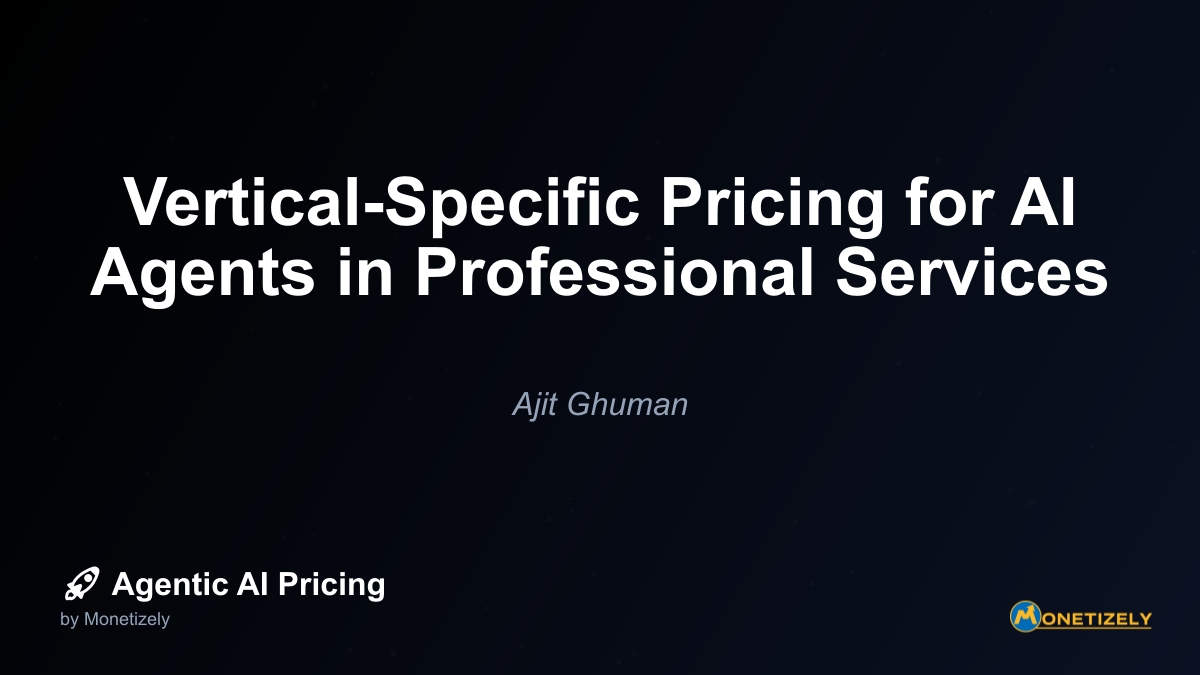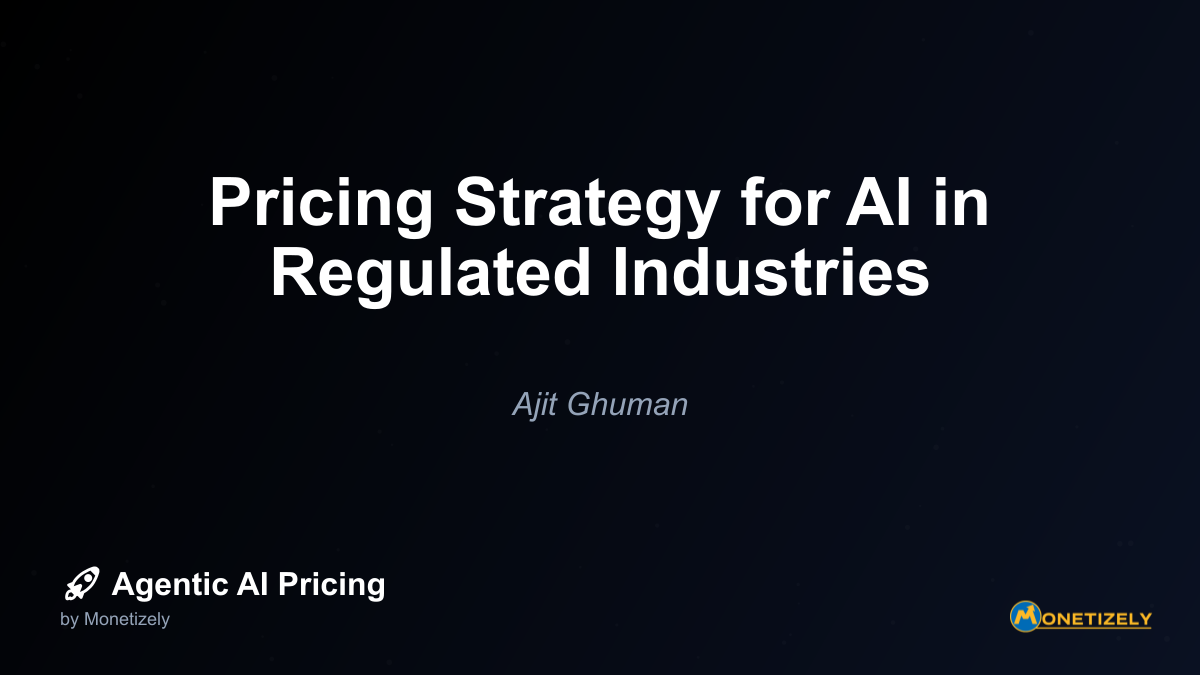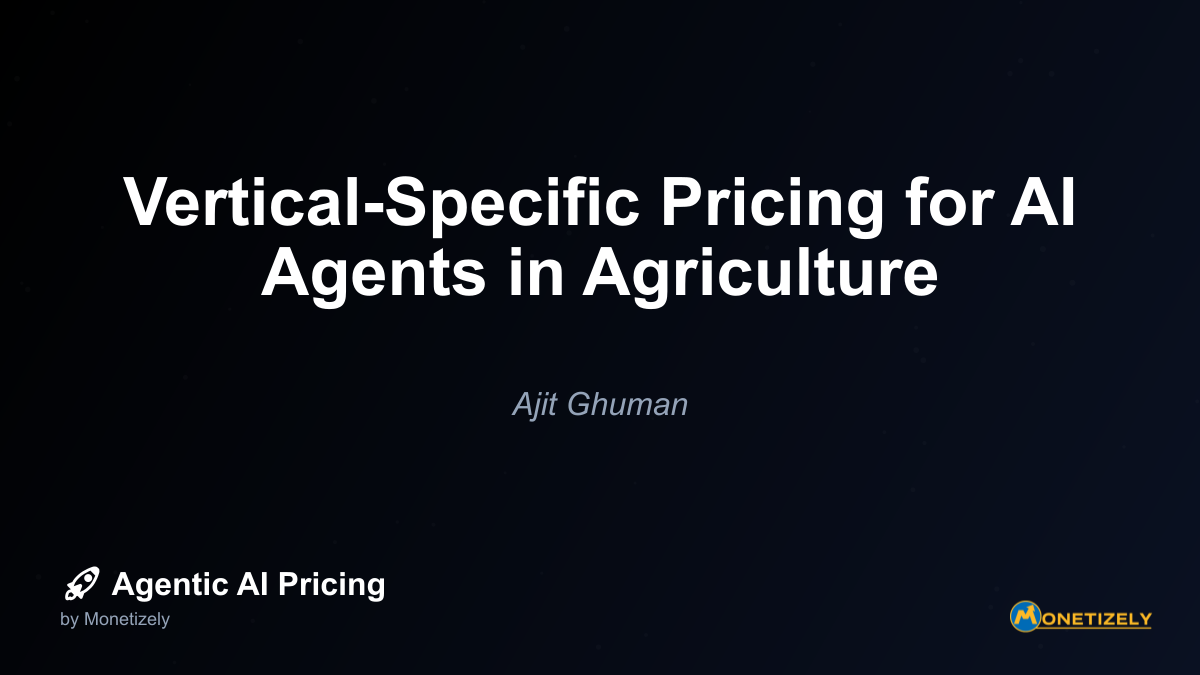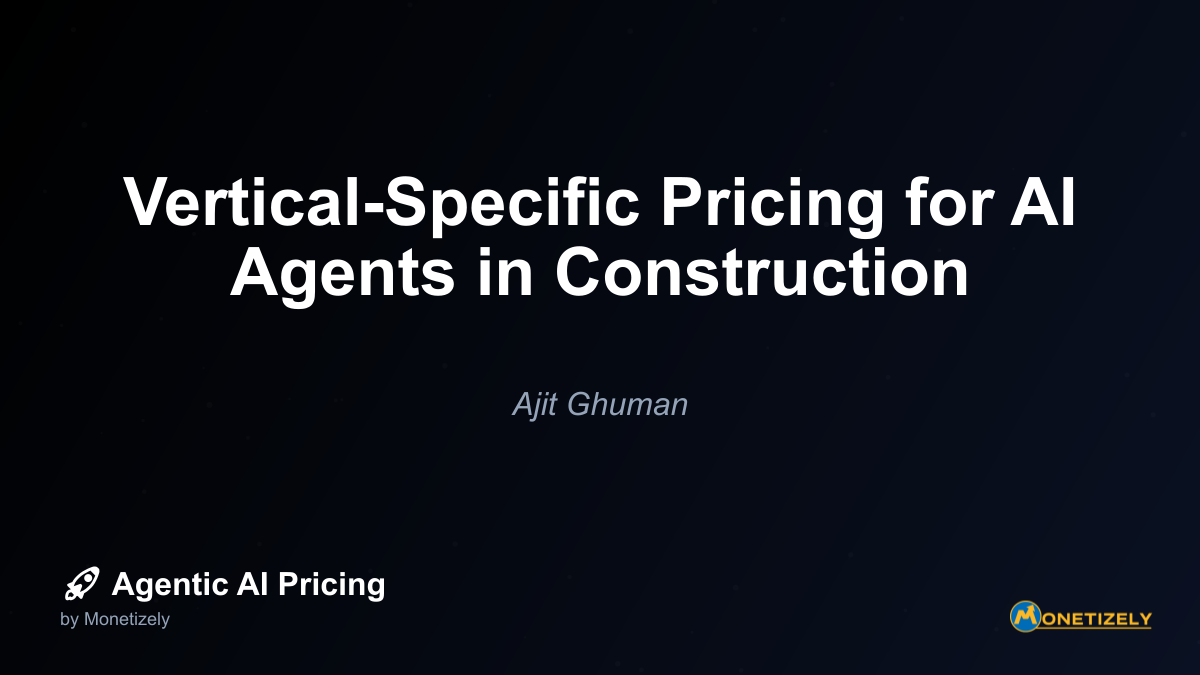· Akhil Gupta · Industry-Specific · 14 min read
AI Pricing for Professional Service Automation
AI and SaaS Pricing Masterclass
Learn the art of strategic pricing directly from industry experts. Our comprehensive course provides frameworks and methodologies for optimizing your pricing strategy in the evolving AI landscape. Earn a professional certification that can be imported directly to your LinkedIn profile.
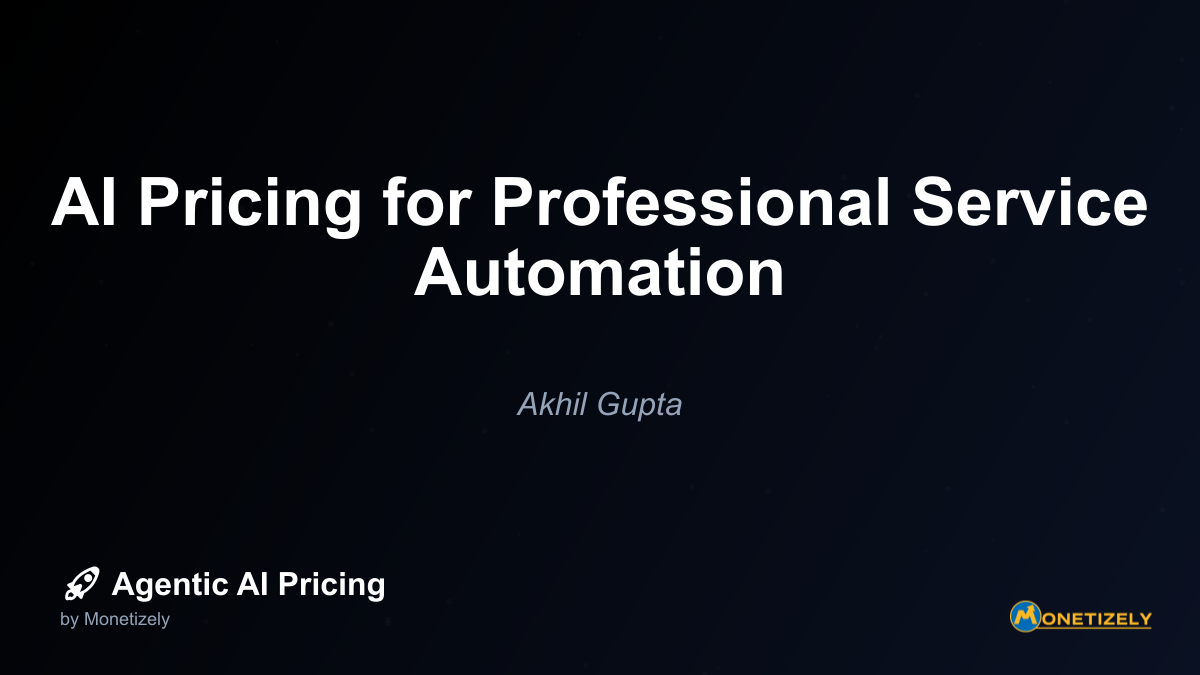
Artificial intelligence is revolutionizing professional services, transforming how law firms, accounting practices, consultancies, and other knowledge-based businesses operate. As these organizations increasingly adopt AI tools to enhance or replace traditional workflows, the question of how to price these solutions becomes paramount. The pricing strategies for AI in professional service automation (PSA) require a nuanced approach that balances technical capabilities, business value, and market positioning.
The Evolution of Professional Service Automation
Professional service firms have traditionally relied on human expertise and billable hours as their primary revenue model. However, AI-powered automation is fundamentally changing this paradigm by handling routine tasks, augmenting professional judgment, and creating new service delivery models. This shift demands innovative pricing approaches that align with the value these tools deliver.
The market for AI in professional services is growing rapidly. Recent data indicates that approximately 72% of organizations regularly used generative AI in 2024, nearly doubling from 2023, with marketing, sales, and IT leading adoption. Around 65% of enterprises now incorporate AI/ML in their processes, and up to 92% of surveyed professionals report using or exploring AI tools, particularly in professional service automation.
This adoption is driven by compelling ROI metrics, including:
- 31.5% increase in customer satisfaction scores
- 24.8% higher customer retention linked to AI-powered support
- 13.8% more inquiries processed per hour
- 60-70% automation of routine employee tasks
- 9% lower cost per assisted contact with omnichannel AI tools
These metrics demonstrate why professional service firms are increasingly integrating AI into their workflows—but how should these tools be priced to reflect their true value?
Current AI Pricing Models in Professional Services
The pricing landscape for AI tools in professional service automation is diverse, with several models emerging as particularly effective. Understanding these models is essential for both providers and purchasers of AI solutions.
Subscription-Based Pricing
Subscription models provide predictable recurring revenue for vendors and predictable costs for customers. These typically come in tiered packages with different feature sets and usage limits.
Example: A legal AI platform might offer a basic tier that provides document analysis and contract review at $50 per user monthly, while a premium tier at $150 per user adds advanced features like precedent analysis and risk assessment.
Advantages: Predictable revenue, scalability, customer loyalty Disadvantages: May not align perfectly with actual value delivered
Usage-Based Pricing
This model charges based on consumption metrics like API calls, documents processed, or time saved. It’s particularly well-suited for AI tools where usage varies significantly between clients.
Example: A document automation tool for accounting firms might charge $0.50 per document processed, allowing smaller firms to start with minimal investment while higher-volume users pay proportionally more.
Advantages: Aligns cost with actual usage, lower barrier to entry Disadvantages: Revenue unpredictability, potential customer budgeting challenges
Value-Based Pricing
Perhaps the most sophisticated approach, value-based pricing ties fees directly to measurable business outcomes generated by the AI solution, such as cost savings, revenue growth, or efficiency gains.
Example: An AI-powered client intake system for consultancies might charge a percentage of demonstrable revenue increases or cost savings achieved through improved lead qualification and client onboarding.
Advantages: Strong alignment with customer ROI, potential for premium pricing Disadvantages: Complexity in measurement, requires deep understanding of client economics
Hybrid Models
Many successful AI tools combine elements of multiple pricing models to balance predictability with value alignment.
Example: A legal research AI platform might charge a base subscription fee plus usage-based components for specialized searches or document generation, with enterprise tiers offering outcome-based pricing components.
Advantages: Flexibility, value alignment, scalability Disadvantages: Potential complexity in communication and implementation
Case Studies: AI Pricing in Professional Services
Law Firms Implementing AI-Driven Dynamic Pricing
Several law firms have begun adopting AI tools to move away from traditional fixed or hourly pricing models toward dynamic pricing based on factors such as project complexity, client urgency, and competitive market data.
These AI systems analyze historical client behavior, case complexity, and competitor rates to suggest optimal pricing that better captures service value and client willingness to pay. Key features include customer segmentation to create client profiles from historical data, negotiation handling tools that predict outcomes based on past trends, and predictive analytics to forecast demand shifts.
However, adoption faces challenges including ethical concerns around personalized pricing that may be perceived as unfair, integration difficulties with existing firm commercial practices, and cultural resistance from partners and associates.
Firms using AI pricing report improvements in capturing the true economic value of legal services, enhanced client loyalty through better pricing customization, and successful shifts from input-based (hourly rate) to output-based (fee per matter) pricing models supported by AI-driven cost savings insights.
Consulting Firms Implementing Value-Based AI Pricing
Consulting firms increasingly use value-based pricing models powered by AI that tie fees to measurable business outcomes generated by AI solutions, rather than traditional time-based billing.
These implementations explicitly define metrics such as cost savings, revenue growth, or efficiency improvements to link payment to results. AI helps assess and predict the potential business impact of consulting interventions, enabling more accurate pricing aligned with client value.
Challenges include establishing clear baseline measures and attribution to AI solutions, which can be complex due to external factors, and ensuring well-crafted contracts to prevent scope creep and protect both parties’ interests.
Outcomes include enhanced client-consultant alignment and partnership mentality, encouragement of innovation and delivery focused on strategic outcomes, and growing adoption as clients demand justifiable ROI on AI investments.
Accounting and Professional Service Firms Using AI for Pricing Automation
The broader professional services sector leverages AI to automate pricing processes such as price monitoring, anomaly detection, and updating pricing based on fresh transactional and market data.
AI is also used to create predictive price bundling—combining multiple services at tailored price points attractive to specific client segments—thus increasing average order value and client exploration of additional services.
These innovations help pricing teams focus on strategic initiatives like market entry and new service launches rather than routine price adjustments.
How Major Tech Players Approach Professional Service AI Pricing
Major technology companies have developed distinct approaches to pricing their AI offerings for professional service automation, with each leveraging their unique strengths and market positioning.
Microsoft
Microsoft (primarily via Azure AI) typically uses a hybrid pricing model blending per-user/user-seat charges with bot or task usage tiers. For example, Microsoft charges around $15 per user or approximately $150 per bot, reflecting a hybrid model that considers both seat-based licensing and usage volume.
This approach is designed to scale with organizational adoption and usage intensity, aiming at broad enterprise integration and flexible scalability. Microsoft’s differentiator is its seamless integration with existing Microsoft products that many professional service firms already use, creating a compelling ecosystem advantage.
Google Cloud
Google Cloud leverages its Vertex AI platform with pricing structured predominantly on consumption basis—billing customers based on the volume and type of AI/ML services used, including compute and storage resources. This aligns with Google’s broader cloud infrastructure pricing model, which combines pay-as-you-go and committed use discounts.
Google emphasizes its vast AI infrastructure and scale but typically integrates AI services within its existing cloud ecosystem to incentivize full platform adoption. Their competitive advantage lies in their advanced AI capabilities and integration with Google’s powerful search and data analytics tools.
IBM
IBM uses a more specialized pricing approach focused on hybrid cloud and regulated industries such as finance and healthcare. IBM Cloud offers:
- Pay-As-You-Go: hourly/monthly billing for compute, storage, and AI/ML services
- Reserved Capacity: discounts for commitments of 1-3 years
- Subscription pricing: fixed prices for specific AI tools like Watson
- Hybrid Cloud Discounts: incentives for mixed on-premises and cloud usage
IBM differentiates strongly through “responsible AI,” enterprise governance, and hybrid cloud integration. Their watsonx platform is built natively for hybrid environments, offering enterprises enhanced control over sensitive data remaining on-premises. IBM also focuses on smaller, “fit-for-purpose” AI models with transparency and cost advantages, claiming up to 7-10x cost efficiency in production vs. hyperscalers’ massive models.
Industry Trends
Across these major players, several trends are emerging:
- Pricing is increasingly value- or outcome-based, especially in support automation where companies like Salesforce and Zendesk only charge when AI agents complete cases, boosting customer satisfaction
- Developer frameworks often remain free to encourage uptake, with monetization coming from premium tiers or enterprise features
- AI infrastructure pricing typically mirrors general cloud infrastructure pricing: pay for compute, storage, data transfer, and throughput with options for reserved capacity and long-term discounts
- Many vendors offer tiered packages (free, good, better, best) combining limits on output volume and functionality, allowing scalable adoption
Technical Considerations Impacting AI Pricing
When developing pricing strategies for AI in professional service automation, several technical factors significantly influence cost structures and pricing models.
Implementation Challenges
Scope of functionality: Solutions managing complex, multi-step processes (e.g., CRM management, predictive forecasting) are more difficult to design, requiring sophisticated configurations that increase cost and time.
Data readiness: AI systems demand clean, structured, and relevant data. Data cleansing, labeling, and transformation efforts add substantially to project scope and budget, especially if proprietary or real-time data streams are involved, requiring ongoing maintenance.
Performance expectations: High reliability, low latency, or real-time capabilities (typical in fraud detection or real-time personalization) necessitate more robust architecture, increasing computational costs.
Integration Costs
Complexity of integrations: AI tools must connect with existing enterprise systems (ERPs, marketing platforms, cloud-based tools). Ready-made connectors reduce effort, but custom APIs and security protocols raise both development and deployment costs.
Deployment support: Includes backend integrations, API development, user training, and adjusting existing workflows—these are often billed separately from licensing and licensing fees.
Maintenance and upgrades: AI implementations require continuous maintenance to remain effective and adapt to business changes, representing ongoing costs.
Infrastructure Requirements
Hardware: AI needs robust physical infrastructure such as high-performance servers, GPUs (for training), TPUs (specialized AI processors), and sufficient data storage solutions (SSD or cloud storage).
Cloud vs. on-premises: Cloud offers scalable, pay-as-you-go models reducing upfront costs but generating recurring expenses, while on-premises infrastructure involves high initial capital expenditure plus maintenance and upgrade costs.
Scalability: As AI applications expand, infrastructure must scale correspondingly, affecting budget and resource planning.
These technical considerations must be factored into pricing strategies to ensure both profitability for vendors and value for customers. Transparency about these factors helps set realistic expectations and build trust with professional service firms adopting AI solutions.
Expert Insights on AI Pricing for Professional Services
Industry leaders and analysts provide valuable perspectives on effective pricing strategies for AI in professional service automation.
“Retainers are ideal for marketers running AI-driven initiatives across channels—offering consistency, priority access, and the flexibility to adjust tactics in real time,” notes one industry expert, highlighting the growing preference for ongoing engagement models over project-based pricing.
Another expert emphasizes the value-based approach: “When you’re solving high-impact problems that generate significant value… you position your service as a valuable, indispensable asset to their operations.”
This sentiment is echoed by PROS, a leading pricing optimization platform: “PROS offers the most advanced pricing science, delivering cutting-edge AI-driven pricing models that adapt to demand shifts, volatility, and data gaps.”
These insights highlight a consensus that successful AI pricing for professional service automation should blend predictable structure with adaptability and value focus, driven increasingly by AI tools themselves to optimize revenue and client outcomes in an evolving market landscape.
Strategic Frameworks for Developing AI Pricing in Professional Services
Developing effective pricing strategies for AI in professional service automation requires structured frameworks that balance technical capabilities, market positioning, and customer value perception. Here are four strategic frameworks to guide this process:
1. Core Value Drivers Framework
This framework bases pricing on the fundamental value drivers that differentiate AI solutions in professional services:
- Performance (speed and response time): Differentiate pricing by latency tiers (standard, premium, enterprise), as faster decision-making often commands higher fees
- Decision quality and accuracy: Include base pricing for standard accuracy with premiums for enhanced precision or risk-adjusted fees tied to results quality
- Integration complexity: Price according to the level of integration—API-only access for entry-level, full workflow automation at premium rates, and domain-specific tailored solutions at top tiers
Implementation steps:
- Identify customer segments and their critical pain points related to PSA (e.g., invoicing speed, error reduction)
- Define performance tiers and accuracy expectations relevant to those segments
- Assess integration depth and value delivered in workflow automation
- Structure tiered pricing reflecting these dimensions
- Validate with market feedback and adjust tiers accordingly
2. Value-Based Pricing Methodology
This approach ties pricing directly to the measurable business impact your PSA AI tool generates:
Implementation steps:
- Conduct business value chain mapping with your client to identify where automation fits into their revenue, costs, or risk profile
- Collect data on current process costs, failure costs, and lost opportunities due to manual workflows
- Quantify direct and indirect benefits—time saved, errors reduced, increased revenue—from automation
- Develop a pricing formula linking fees to a percentage of these benefits or agreed-upon KPIs
- Structure contracts to include clear metrics, baseline measurements, and review points
- Monitor performance and adjust pricing based on realized impact
Key practical tip: Engage in deep discovery to understand client economics—not just technical specs—allowing precise value quantification for negotiations.
3. Usage-Based and Tiered Subscription Pricing
For PSA tools interfacing as cloud or SaaS platforms:
- Usage-based pricing: Charge based on actual consumption metrics, such as API calls, automated tasks executed, or data processed
- Per-user pricing: Charge a fixed fee per user accessing the automation tools within the organization
- Hybrid tiered subscriptions: Combine fixed base fees with add-ons for higher usage or premium features (e.g., advanced AI models, integration with other enterprise systems)
Implementation guidance:
- Define metrics that correlate with customer value (e.g., tasks automated, users onboarded)
- Provide transparent pricing tiers allowing customers to scale usage
- Leverage usage data to upsell or customize plans as client needs evolve
- Include premium support or integration services in higher-priced tiers
4. Lifecycle and Skill-Level Price Adjustments
This framework recognizes that pricing should evolve as both your AI solution and market mature:
- Start with competitive or value-based pricing
- Plan periodic price evaluations (e.g., every 6 months) aligned with customer success, case studies, and market position
- Adjust pricing as expertise and PSA tool maturity increase
- Consider skill-based pricing for consulting or customization services attached to the PSA tool’s AI component (e.g., AI integration consulting at premium hourly rates)
These frameworks can be combined effectively: start with value-based discussions to justify a baseline price, layer in usage or tiered subscriptions for scalability, and refine pricing as the product matures and delivers demonstrated client impact.
The Future of AI Pricing in Professional Services
The future of AI pricing in professional service automation looks promising, with several key trends emerging that will shape pricing strategies in the coming years.
Market Growth and Evolution
The AI as a Service (AIaaS) market is projected to grow sharply, potentially reaching $200 billion by 2032, driven by demand for cloud-based, scalable AI solutions reducing infrastructure barriers for businesses.
Advances in natural language processing, computer vision, and automated machine learning will enhance AI platform capabilities, supporting more accurate predictions and real-time intelligent decision-making. These technological improvements will enable more sophisticated pricing models that can better capture the value delivered.
Emerging Pricing Trends
Several pricing trends are likely to dominate the future landscape:
Outcome-based pricing acceleration: More AI vendors will shift toward pricing models directly tied to measurable business outcomes, such as cost reduction, revenue enhancement, or risk mitigation.
Micro-service pricing: As AI capabilities become more modular, pricing will increasingly reflect specific micro-services rather than monolithic platforms, allowing professional service firms to pay only for the exact capabilities they need.
Dynamic pricing optimization: AI tools will increasingly use AI themselves to optimize their own pricing, analyzing usage patterns, value delivered, and competitive positioning to suggest optimal pricing strategies.
Ecosystem-based pricing: As AI tools become more interconnected, pricing models will evolve to reflect the value of entire ecosystems rather than individual tools, with bundled offerings and integration-based discounts.
Transparency-driven models: In response to growing concerns about AI ethics and costs, more transparent pricing models will emerge that clearly link fees to specific capabilities, usage, and outcomes.
Challenges and Considerations
Despite the positive outlook, several challenges remain:
Data privacy concerns: As AI tools process increasingly sensitive professional service data, pricing models must account for enhanced security and compliance features.
Integration complexities: The need to seamlessly integrate with existing professional service workflows will continue to influence pricing structures and implementation costs.
Skilled workforce shortages: The limited availability of AI expertise will affect implementation costs and potentially drive premium pricing for high-demand specialized capabilities.
Ethical considerations: As AI takes on more decision-making roles in professional services, pricing models must account for ethical considerations, transparency, and accountability.
Implementation Roadmap for AI Pricing in Professional Services
For organizations looking to implement or refine their AI pricing strategies in professional service automation, the following roadmap provides a structured approach:
Phase 1: Discovery and Analysis (1-2 months)
- Market assessment: Analyze competitor pricing models, customer expectations, and industry benchmarks
- Customer segmentation: Identify key customer segments and their specific needs, pain points,
Co-Founder & COO
Akhil is an Engineering leader with over 16+ years of experience in building, managing and scaling web-scale, high throughput enterprise applications and teams. He has worked with and led technology teams at FabAlley, BuildSupply and Healthians. He is a graduate from Delhi College of Engineering and UC Berkeley certified CTO.
Pricing Strategy Audit
Let our experts analyze your current pricing strategy and identify opportunities for improvement. Our data-driven assessment will help you unlock untapped revenue potential and optimize your AI pricing approach.

